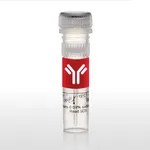Thermo Fisher Scientific GFAP Monoclonal Antibody (GA5), Alexa Fluor 488, eBioscience
다른 상품 둘러보기
Applications
Tested Dilution
Publications
Western Blot (WB)
-
View 3 publications 3 publications
Immunohistochemistry (IHC)
-
View 37 publications 37 publications
Immunohistochemistry (Paraffin) (IHC (P))
10 µg/mL
Immunohistochemistry (Frozen) (IHC (F))
10 µg/mL
View 2 publications 2 publications
Immunocytochemistry (ICC/IF)
10 µg/mL
View 8 publications 8 publications
Flow Cytometry (Flow)
Assay-Dependent
View 6 publications 6 publications
Product Specifications
Species Reactivity
Chicken, Human, Mouse, Pig, Rabbit, Rat
Published species
Human, Mouse, Rabbit, Rat
Host/Isotype
Mouse / IgG1
Recommended Isotype Control
Mouse IgG1 kappa Isotype Control (P3.6.2.8.1), Alexa Fluor™ 488, eBioscience™
Class
Monoclonal
Type
Antibody
Clone
GA5
Conjugate
Alexa Fluor™ 488 Alexa Fluor™ 488 Alexa Fluor™ 488
View additional formats
Excitation/Emission Max
499/520 nm View spectra 
Form
Liquid
Concentration
0.5 mg/mL
Purification
Affinity chromatography
Storage buffer
PBS, pH 7.2
Contains
0.09% sodium azide
Storage conditions
4° C, store in dark, DO NOT FREEZE!
Shipping conditions
Ambient (domestic); Wet ice (international)
RRID
AB_10597754
Product Specific Information
Description: This GA5 monoclonal antibody reacts with human, mouse, rat, chicken, rabbit, and pig glial fibrillary acidic protein (GFAP). This 49-kDa type III intermediate filament protein is expressed in neural tissues and distinguishes astrocytes from other glial cells during central nervous system development. Three alternative splice variants of GFAP exist; however, alpha-GFAP is the predominant form expressed in astrocytes. GFAP can co-assemble with vimentin and nestin in astrocytes, but such associations are not required for assembly. Like other intermediate filaments, GFAP assembly is dependent on phosphorylation and dephosphorylation of the N-terminal domain. Studies have demonstrated that mutations in the GFAP gene lead to Alexander disease. Moreover, GFAP has also been shown to be overexpressed in certain glial-derived tumors.
Applications Reported: This GA5 antibody has been reported for use in intracellular staining followed by flow cytometric analysis, immunohistology staining of frozen and FFPE tissue sections, and immunocytochemistry.
Applications Tested: This GA5 antibody has been tested by immunocytochemistry of fixed and permeabilized C6 cells and by immunohistochemistry of formalin-fixed paraffin embedded human tissue using low pH antigen retreival. This can be used at less than or equal to 10 µg/mL. It is recommended that the antibody be carefully titrated for optimal performance in the assay of interest.
Excitation: 488 nm; Emission: 519 nm; Laser: Blue Laser.
Filtration: 0.2 µm post-manufacturing filtered.
Target Information
GFAP (Glial fibrillary acidic protein) is a member of the class III intermediate filament protein family. GFAP is heavily and specifically expressed in astrocytes and certain astroglia of the central nervous system, in satellite cells of peripheral ganglia, and in non-myelinating Schwann cells of peripheral nerves. In addition, neural stem cells strongly express GFAP. Antibodies to GFAP are very useful as markers of astrocytic cells. In addition, many types of brain tumor, presumably derived from astrocytic cells, heavily express GFAP. GFAP is also found in the lens epithelium, Kupffer cells of the liver, in some cells in salivary tumors and has been reported in erythrocytes. GFAP is used as a marker to distinguish astrocytes from other glial cells during development. Mutations in this gene cause Alexander disease, a rare disorder of astrocytes in the central nervous system. Alternative splicing of the GFAP gene results in multiple transcript variants encoding distinct isoforms.
For Research Use Only. Not for use in diagnostic procedures. Not for resale without express authorization.
배송/결제/교환/반품 안내
배송 정보
| 기본 배송비 |
| 교환/반품 배송비 |
|
|---|---|---|---|
| 착불 배송비 |
| ||
| 교환/반품 배송비 |
| ||
결제 및 환불 안내
| 결제수단 |
|
|---|---|
| 취소 |
|
| 반품 |
|
| 환급 |
|
교환 및 반품 접수
| 교환 및 반품 접수 기한 |
|
|---|---|
| 교환 및 반품 접수가 가능한 경우 |
|
| 교환 및 반품 접수가 불가능한 경우 |
|
교환 및 반품 신청
| 교환 절차 |
|
|---|---|
| 반품 절차 |
|

